| Abbreviation | EURING |
|---|---|
| Formation | 1963 |
| Purpose | Co-ordination of bird ringing in Europe |
Region served | Europe |
| Website | euring |
The European Union for Bird Ringing (EURING) is the co-ordinating organisation for European bird ringing schemes.
Contents

| Abbreviation | EURING |
|---|---|
| Formation | 1963 |
| Purpose | Co-ordination of bird ringing in Europe |
Region served | Europe |
| Website | euring |
The European Union for Bird Ringing (EURING) is the co-ordinating organisation for European bird ringing schemes.

EURING was founded in France in 1963, partly in response to a meeting at the 13th International Ornithological Congress (Ithaca, New York, June 1962). [1] [2]
EURING has established the EURING Exchange Code to enable data interchange between members, and the central EURING Databank to collect records from all members in a central database.
The EURING Exchange Code (or EURING Code) is a data exchange format that describes bird ringing information and ringing recoveries. Its main use is to enable data exchange between EURING members (that each have their own databases and formats) and between members and the EURING Databank. [3]
The code was established in the 1966 EURING meeting by adapting a Dutch punch card code that originated in 1963. [4] [5] The EURING Exchange Code has since then been developed further as technology improved, resulting in newer editions in 1979 [6] and 2000. [7] [8] The code had moved from punch cards to ASCII code to be used in text files and databases. The 2000 code was modified into the 2000+ version, [9] and later succeeded by the 2020 version, which is the current standard. [10]
EURING codes are also used to identify species in other ornithological research, such as the The EBCC Atlas of European Breeding Birds. [11]
In 1977, EURING founded the EURING Databank (EDB) to collect records from all members in a central location. The EDB was initially hosted at the Netherlands Institute of Ecology. [12] In 2006, the hosting was moved to the British Trust for Ornithology (BTO). [13]
The establishment of the EURING 2000 Exchange Code was a driver for the rapid advancement in capture-recapture studies and analyses. [14]
EURING data is used in scientific research on ornithology or related subjects. Research topics include migration routes, [15] wintering areas [16] [17] and staging areas, [18] and survival rates. [19] Bird ringing data such as in the EDB is also relevant for conservation. [20]
Other applications include usage for detecting avian influenza patterns, as seen in the EFSA Migration Mapping Tool [21] and Bird Flu Radar. [22] [23]
The EDB data is combined with Movebank data to form the publicly available Eurasian African Bird Migration Atlas, [24] developed by the Convention on the Conservation of Migratory Species of Wild Animals under the United Nations Environment Programme. [25] [26]

Ornithology is a branch of zoology that concerns the study of birds. Several aspects of ornithology differ from related disciplines, due partly to the high visibility and the aesthetic appeal of birds. It has also been an area with a large contribution made by amateurs in terms of time, resources, and financial support. Studies on birds have helped develop key concepts in biology including evolution, behaviour and ecology such as the definition of species, the process of speciation, instinct, learning, ecological niches, guilds, island biogeography, phylogeography, and conservation.
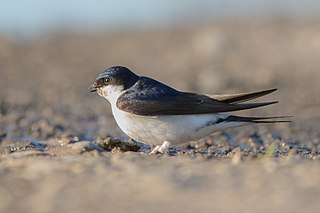
The western house martin, sometimes called the common house martin, northern house martin or, particularly in Europe, just house martin, is a migratory passerine bird of the swallow family which breeds in Europe, north Africa and across the Palearctic; and winters in sub-Saharan Africa and tropical Asia. It feeds on insects which are caught in flight, and it migrates to climates where flying insects are plentiful. It has a blue head and upperparts, white rump and pure white underparts, and is found in both open country and near human habitation. It is similar in appearance to the two other martin species of the genus Delichon, which are both endemic to eastern and southern Asia. It has two accepted subspecies.

The common crane, also known as the Eurasian crane, is a bird of the family Gruidae, the cranes. A medium-sized species, it is the only crane commonly found in Europe besides the demoiselle crane and the Siberian crane that only are regular in the far eastern part of the continent. Along with the sandhill crane, demoiselle crane and the brolga, it is one of only four crane species not currently classified as threatened with extinction or conservation dependent on the species level. Despite the species' large numbers, local extinctions and extirpations have taken place in part of its range, and an ongoing reintroduction project is underway in the United Kingdom.

Bird migration is the regular seasonal movement, often north and south, along a flyway, between breeding and wintering grounds. Many species of bird migrate. Migration carries high costs in predation and mortality, including from hunting by humans, and is driven primarily by the availability of food. It occurs mainly in the northern hemisphere, where birds are funnelled onto specific routes by natural barriers such as the Mediterranean Sea or the Caribbean Sea.

The European roller is the only member of the roller family of birds to breed in Europe. Its overall range extends into the Middle East, Central Asia and the Maghreb.
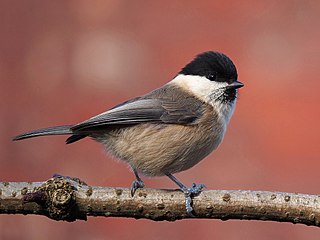
The willow tit is a passerine bird in the tit family, Paridae. It is a widespread and common resident breeder throughout temperate and subarctic Europe and across the Palearctic. The plumage is grey-brown and off-white with a black cap and bib. It is more of a conifer specialist than the closely related marsh tit, which explains it breeding much further north. It is resident, and most birds do not migrate.

The Eurasian or common whimbrel, also known as the white-rumped whimbrel in North America, is a wader in the large family Scolopacidae. It is one of the most widespread of the curlews, breeding across much of subarctic Asia and Europe as far south as Scotland. This species and the Hudsonian whimbrel have recently been split, although some taxonomic authorities still consider them to be conspecific.

The Eurasian woodcock is a medium-small wading bird found in temperate and subarctic Eurasia. It has cryptic camouflage to suit its woodland habitat, with reddish-brown upperparts and buff-coloured underparts. Its eyes are set far back on its head to give it 360-degree vision and it probes in the ground for food with its long, sensitive bill, making it vulnerable to cold weather when the ground remains frozen.
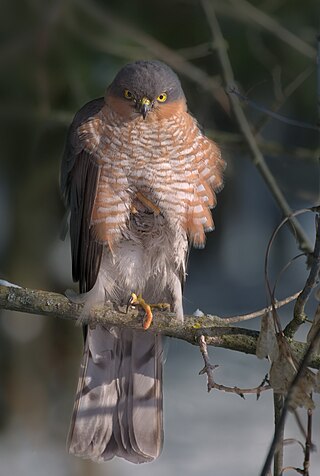
The Eurasian sparrowhawk, also known as the northern sparrowhawk or simply the sparrowhawk, is a small bird of prey in the family Accipitridae. Adult male Eurasian sparrowhawks have bluish grey upperparts and orange-barred underparts; females and juveniles are brown above with brown barring below. The female is up to 25% larger than the male – one of the greatest size differences between the sexes in any bird species. Though it is a predator which specialises in catching woodland birds, the Eurasian sparrowhawk can be found in any habitat and often hunts garden birds in towns and cities. Males tend to take smaller birds, including tits, finches, and sparrows; females catch primarily thrushes and starlings, but are capable of killing birds weighing 500 g (18 oz) or more.
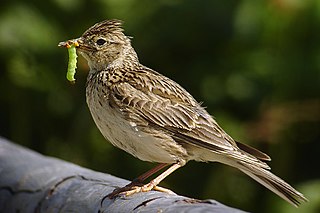
The Eurasian skylark is a passerine bird in the lark family, Alaudidae. It is a widespread species found across Europe and the Palearctic with introduced populations in Australia, New Zealand and on the Hawaiian Islands. It is a bird of open farmland and heath, known for the song of the male, which is delivered in hovering flight from heights of 50 to 100 metres. The sexes are alike. It is streaked greyish-brown above and on the breast and has a buff-white belly.

The sedge warbler is an Old World warbler in the genus Acrocephalus. It is a medium-sized warbler with a brown, streaked back and wings and a distinct pale supercilium. Sedge warblers are migratory, crossing the Sahara to get from their European and Asian breeding grounds to spend winter in Africa. The male's song is composed of random chattering phrases and can include mimicry of other species. The sedge warbler is mostly insectivorous.
Christopher John Mead was a popular British ornithologist, author and broadcaster, and an influential member of the British Trust for Ornithology (BTO).

The British Trust for Ornithology (BTO) is an organisation founded in 1932 for the study of birds in the British Isles. The Prince of Wales has been patron since October 2020.

Bird ringing (UK) or bird banding (US) is the attachment of a small, individually numbered metal or plastic tag to the leg or wing of a wild bird to enable individual identification. This helps in keeping track of the movements of the bird and its life history. It is common to take measurements and examine conditions of feather molt, subcutaneous fat, age indications and sex during capture for ringing. The subsequent recapture or recovery of the bird can provide information on migration, longevity, mortality, population, territoriality, feeding behavior, and other aspects that are studied by ornithologists. Other methods of marking birds may also be used to allow for field based identification that does not require capture.
Jeremy John Denis Greenwood CBE is a British ornithologist and was Director of the British Trust for Ornithology (BTO) from 1988 until he retired in September 2007.
EDB may refer to:
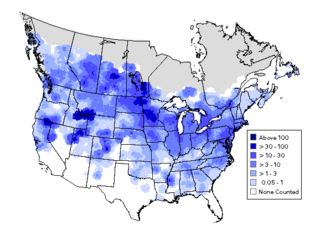
A bird atlas is an ornithological work that attempts to provide information on the distribution, abundance, long-term change as well as seasonal patterns of bird occurrence and make extensive use of maps. They often involve a large numbers of volunteers to cover a wide geographic area and the methods used are standardized so that the studies can be continued in the future and the results remain comparable. In some cases the species covered may be restricted to those that breed or are resident. Migration atlases on the other hand cover migratory birds depict maps showing summaries of ringing and recoveries.
Professor David Norman is a British Chartered Physicist and ornithologist, he has lived in Cheshire since 1978.
Ward J. M. Hagemeijer is a Dutch ecologist and author who publishes about birds and about wetlands. In 1997 Hagemeijer authored The EBCC Atlas of European Breeding Birds.

The use of thermal imaging devices to monitor birds began in the 1960s. It underwent significant development from the end of the 20th century onwards. This was, at least in part, due to improvements in the quality and portability of thermal-imaging devices, and reductions in their cost.